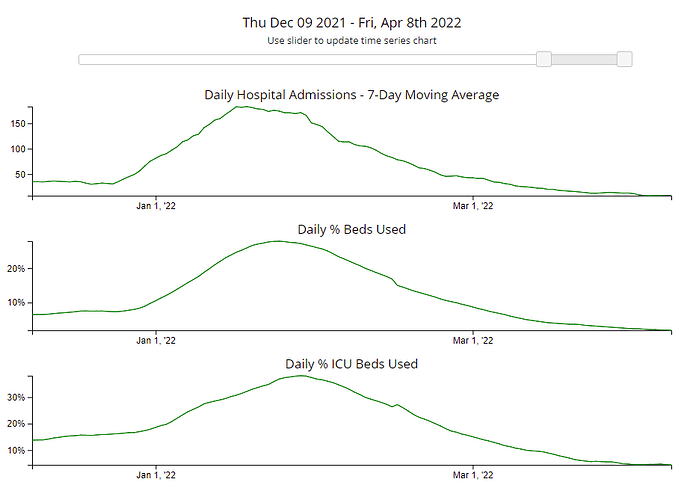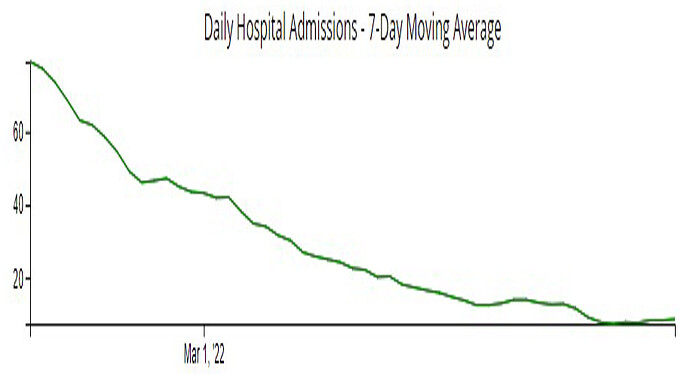Indeed. But if cases should continue to go up 20% a week that could be an early warning of a new surge.
Since in LA County BA.2 started rapidly taking over from BA.1 in late February without stopping the downward trend in cases, it seems likely that this week’s rise is due to getting rid of mask requirements etc. Here’s the CDC data for LA County:
| 2022-02-24 | 2022-03-03 | 2022-03-10 | 2022-03-24 | 2022-03-17 | 2022-03-31 | 2022-04-07 | |
|---|---|---|---|---|---|---|---|
| COVID Inpatient Bed Utilization | 7.7% | 5.5% | 4.1% | 2.5% | 3.1% | 2.0% | 1.7% |
| COVID Hospital Admissions per 100k | 10.6 | 7.4 | 7.2 | 3.3 | 4.4 | 2.4 | 2.2 |
| Cases per 100k | 216.5 | 111.4 | 88.6 | 121.2 | 71.4 | 55.7 | 55.5 |
These data look to have pretty much the same general trends as those for Alameda County.
The hospital stats have more bouncing up and down rather than a steady decline.
True, but the trends are the same.
Here’s another way to look at the recent hospitalization trends (from CDC website). These plots are for San Diego County covid patients and are current as of last Friday.
All three plots show very encouraging trends with no sign of any sustained adverse changes (upward), for now. If the vertical scales on these plots were to be expanded, the plots would probably show numerous “bounces”, but the averaged trends since February have been downward. The current hospitalization numbers are very low.
The lines are smooth because they’re seven-day moving averages.
I don’t want to belabor the point, but even the 7-day averages exhibit wiggles. They don’t form a perfectly smooth curve. Here’s the Hospital Admissions plot from my previous post where I’ve greatly expanded the ordinate (vertical axis), and show only the segment for the past couple of weeks on the abscissa:
(Note that the horizontal line at the bottom of the plot isn’t zero.)
Previously added comment in this current post is withdrawn.
I was wondering how there could be more than 10 data points in the past 10 days, if the 7-day moving average is calculated once daily.
The data in the last part of the expanded graph that I posted earlier are plotted from March 1st, not April 1st. My mistake.
I see that unmasking on planes, trains, and automobiles (driven by Uber, anyway) has been extended again, this time for two weeks more until May 3.
I still haven’t read anything about any outbreaks that have been traced to being on an airplane. I don’t know about trains, but airplanes have excellent airflow patterns, air replacement rates, and HEPA filtration.
Air travel causes mixing between regions and countries, of course, but flying on an airplane is pretty darn safe.
Do they really? B/c I can’t see how I’m not going to get a face-full of whatever from someone who is sitting within a few rows of me. But I also don’t know much about the ventilation on a commercial plane.
You mean the mask mandate has been extended.
The notion that planes are safe is largely airline propaganda. Where else would you sit next to strangers for hours? Without vaccination screening or recent negative test results? Yes, planes have air filters, but there’s not an intake vent over every seat, so an infected passenger’s exhaled virus particles can get drawn past so you inhale them. And what about when there’s a problem and you’re sitting for minutes or hours on the runway with the ventilation off?
That’s an issue if you’re in near proximity to anyone who is sneezing or coughing anywhere, like in a grocery store. I used to actually immediately hold my breath as long as possible after someone in the row behind me on an airplane would sneeze or cough, during my great many business flights. If someone in front of me is sneezing, I don’t think I’d have a problem (but those in the row ahead of that person would). Being on an airplane where people are sneezing or coughing has always been a problem, but otherwise I think that the environment is pretty safe.
I’m not sure that I can disagree with Robert’s comment about being on the ground in an airplane, but I don’t think that the ventilation is turned off. I just don’t know.
The October article in Health24 that Robert posted is the first one that I’ve seen citing spread of covid on an airplane. There are probably others, but consider the many thousands of flights where this did not occur (no traceback to a flight).
Yes - that was often mentioned even by airline people that the ventilation at ground is quite different (and less effective) as during flight. In addition, there are articles out which describe that particular with omicron and BA2 the required viral load for infection might be so low that airplanes actually become much more likely to be a sourve for covid infection
Thanks for clarifying the ground ventilation point. One might think that they’d leave it turned on these days, in the covid era.
I read somewhere that there are too many pollutants get into the plane if it is turned on for too long on ground.
If you didn’t know about people infecting each other on planes, you haven’t been following the news very closely. There would have been far more such reports if it weren’t for people wearing masks and in some places requirements of proof of vaccination and/or a recent negative test.
Passenger A in this diagram, who was asymptompatic until a couple of days after the flight, infected at least four other passengers.
https://wwwnc.cdc.gov/eid/article/27/3/20-4714_article
You don’t have to sneeze or cough to spread Covid. Aerosols, not just droplets, remember?
Yep - breathing is often enough



